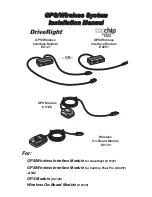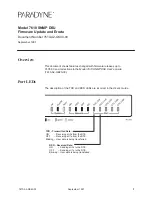
© 2022 Radiodetection Ltd
24
5.7 Sweep and search
There are a number of techniques available for locating
unknown lines in an area. Using these techniques is
particularly important before conducting any excavation
work to help ensure that buried lines are not damaged.
Passive sweep
A passive sweep is used to locate Power, Radio or CPS
signals that may radiate from buried conductors.
To perform a passive sweep:
1 Press the key to select the passive frequency you
wish to locate. You can select from the following
passive frequencies (model dependent):
•
Power
•
Radio
•
CPS (Cathodic Protection System)
2 Adjust the sensitivity to maximum; reduce the
sensitivity to keep the bar graph on scale when there
is a response.
3 Traverse the area in a grid search, at a steady walk,
and hold the locator comfortably with the antenna in
line with the direction of movement and at right
angles to any lines that may be crossed.
Figure 5.4: Passive sweep
Stop when the locator response rises to indicate the
presence of a line. Pinpoint the line and mark its position.
Trace the line out of the area being searched. Resume
grid search in the area.
In some areas there may be a confusing amount of 50 /
60Hz power signals. Lift the locator 50mm / 2” from the
ground and continue the sweep, or use the key to
switch from Power mode and use Power Filters to
discriminate individual lines.
Switch the locator to Radio Mode. Increase sensitivity to
maximum and repeat the above grid search procedure
over the area. Pinpoint, mark, and trace out any lines
that are located.
In most, but not all areas, radio mode will locate lines
that do not radiate power signals and a grid search
should be made in both power and radio modes.
Inductive search
An inductive search procedure is a more certain
technique for locating unknown lines. This type of search
requires a transmitter and locator and two people. This
type of search is referred to as a ‘two person sweep’.
Before starting the sweep, define the area of search and
the probable direction of lines crossing the area. Ensure
the transmitter is switched on in induction mode.
Figure 5.5: Inductive search
The first person operates the transmitter and the second
person operates the locator. The transmitter induces a
signal onto lines as it passes over them and the lines are
then detected with the locator at a suitable distance
away from the transmitter (around 15 meters / 50 feet –
although this will depend upon the level of induction
power used.)
Hold the transmitter with its length aligned with the
assumed direction of any lines.
The second person holds the locator at the start of the
area to be searched and with the locator antennas at
right angles to the probable direction of the buried lines.
Set the locator sensitivity level as high as possible
without the locator picking up any airborne signals
directly from the transmitter.
When the transmitter and locator are in line both
operators start to move forward in parallel. The operator
with the locator sweeps it backwards and forwards,
keeping the locator vertical, as they proceed in parallel
with the transmitter. This method allows for
misalignment of the transmitter, locator and buried line.
The transmitter applies the strongest signal to the lines
directly below it, which are then located with the locator.
Move the transmitter from side to side to establish the
highest signal which indicates that the transmitter is also
directly above the line(s).
Mark the ground at the point of each Peak signal
detected with the locator. Repeat the search along any
other possible paths of lines. Once the positions of any
lines have been marked, reverse positions, place the
transmitter over and along each line in turn, and trace
the line out of the search area.
















































